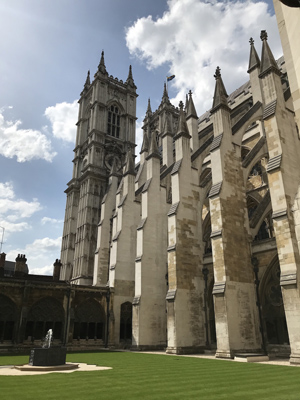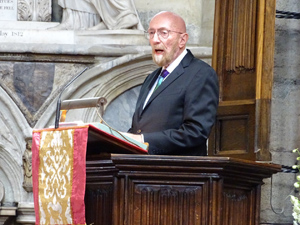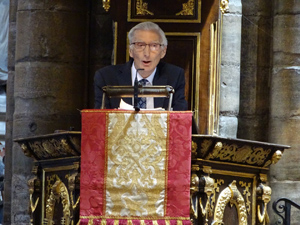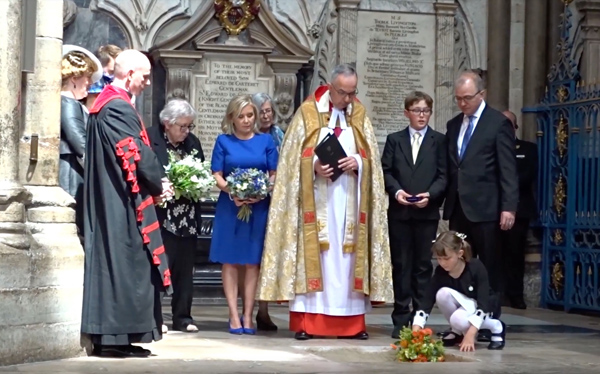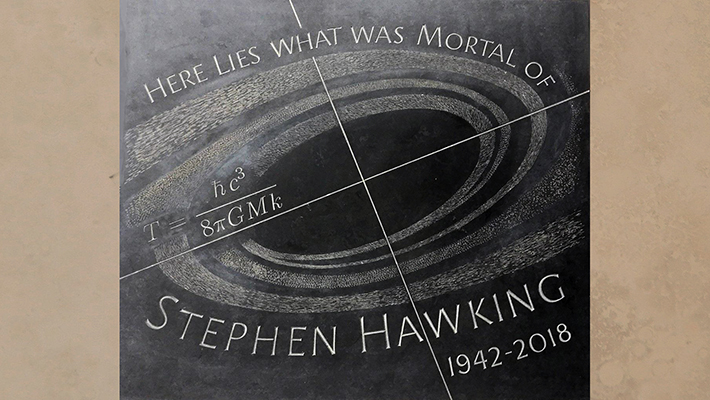Professor Stephen Hawking's Memorial Service at Westminster Abbey
More than a thousand people gathered at Westminster Abbey on 15 June to pay their final respects to Stephen Hawking, who died in March, and to witness his ashes being laid under a memorial stone between the graves of Isaac Newton and Charles Darwin.
As a testament to the public interest in this extraordinary figure of science, more than 27,000 people had applied to be present at the memorial service, from which a thousand were picked. They attended along with Stephen’s family, as well as friends and colleagues from around the world. Those present included the Culture Secretary Matt Hancock; Leader of the Opposition Jeremy Corbyn; musician Nile Rogers; actress Lily Cole; comedian David Walliams; and television presenter Piers Morgan. Also attending was Professor Brian Cox, who recalled reading Stephen Hawking’s international bestseller A Brief History of Time as a twenty-year-old and deciding on a career in physics as a result.
Benedict Cumberbatch, star of the 2004 TV movie Hawking, read the first lesson from the Book of Wisdom. Astronaut Tim Peake read from Shelley’s poem “Queen Mab,” which evokes the wonders of the universe. Nobel Laureate Kip Thorne and Astronomer Royal Martin Rees paid tribute to Stephen. Professor Thorne called him “a marvellous explorer”: “He explored black holes. He explored the universe and how it began. He explored the laws that govern the universe and govern all it contains.”
Lord Rees recalled first meeting Stephen when a graduate student at Cambridge and shortly after Stephen’s diagnosis of motor neurone disease: “Astronomers are used to big numbers. But few could be as big as the odds I’d have given, back then in 1964, against witnessing his amazing crescendo of achievement spanning more than 50 years.” He concluded his address by saying that Stephen Hawking’s name “will live in the annals of science: nobody else since Einstein has done more to deepen our understanding of space, time, and gravity. Millions have had their cosmic horizons widened by his books and lectures; and even more, worldwide, have been inspired by a unique example of achievement against all the odds.”
Professor Hawking’s ashes were buried under a memorial stone on which is inscribed his equation for the Hawking temperature of black holes, the most compact objects in the universe. His most famous work was to show that black holes radiate microscopic particles and eventually evaporate – the first scientific discovery to bring together the two great revolutions of twentieth-century physics: quantum mechanics and general relativity. It remains a touchstone that drives fundamental research today. Other profound contributions to cosmology included showing that the universe must have had a beginning in time and that quantum fluctuations in the primordial universe led to all the structure we observe today: galaxies, stars and planets.
Professor Hawking will of course also be remembered for the enormous courage and good humour with which he faced his illness, an encouraging example to many others in challenging circumstances. At the opening of the London Paralympics in 2012, Stephen said that “There was no such thing as a run-of-the-mill human being. No matter how difficult life may seem, there is always something you can do and succeed at!” The Memorial Service celebrated both his life of scientific achievement and his triumph over adversity. Professor Paul Shellard (CTC Director) said afterwards, “Stephen’s passing was a sad loss for us all, but now it is time to build on his profound legacy and to ensure that future generations are also inspired by his positive vision.”
To mark the occasion of the memorial service, Professor Hawking’s own words were beamed towards the nearest known black hole to Earth, about 3,500 light years away, by the European Space Agency. The broadcast was sent by a satellite dish in Spain, accompanied by original music by the Oscar-winning composer Vangelis. His daughter Lucy Hawking explained that the transmission was a “beautiful and symbolic gesture that creates a link between our father’s presence on this planet, his wish to go into space and his explorations of the universe in his mind.”
Professor Hawking's ashes were interred in the Scientist's Corner in Westminster Abbey where the graves of 18 other prominent scientists are buried.
(Picture credit: Westminster Abbey)
Video excerpts from the service, including the interment of Professor Hawking’s ashes, addresses by Professor Thorne and Lord Rees, can be found on the Westminster Abbey website. It also contains the Order of Service.
Professor Thorne’s address (PDF)
Lord Rees’ address (PDF)
Memorial stone for Professor Stephen Hawking at Westminster Abbey, designed with a rotating and accreting black hole. It also depicts the equation for the Hawking temperature T of a black hole with mass M, demonstrating that a black hole will eventually evaporate through thermal radiation. This is one of Professor Hawking's most profound insights because, for the first time, it brought together the theory of the microscopic (quantum mechanics) with that of the very large (general relativity). The fundamental constants in the equation reveal the deep connections unveiled between different branches of physical theory: G is Newton's constant of gravitation, which is so important also in Einstein's theory of general relativity, c is the speed of light from special relativity measured by all observers, ℏ (h-bar) is the reduced Planck's constant, famous from the quantum uncertainty principle, and k is Boltzmann's constant associated with thermodynamics and statistical physics. This equation is closely related to the black hole entropy S associated with the area A of a black hole horizon, an equation which connects the same set of fundamental constants,
(Picture credit: Westminster Abbey)

